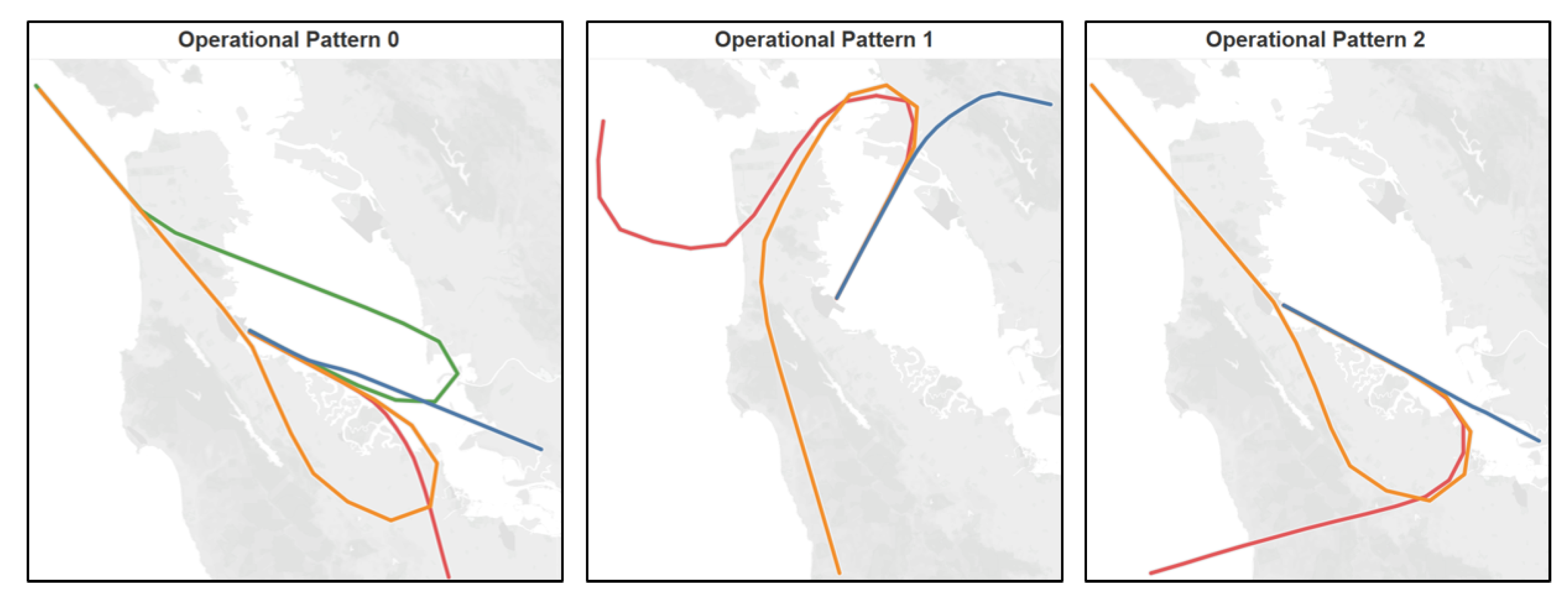Characterizing Terminal Airspace Operational States and Detecting Airspace-Level Anomalies †
Abstract
:1. Introduction and Background
2. Method
2.1. Operational State Representation
2.2. Operational State Characterization
3. Implementation and Results
3.1. Operational State Representation
3.2. Operational State Characterization
4. Conclusions
Author Contributions
Funding
Conflicts of Interest
References
- Condé Rocha Murça, M. Data-Driven Modeling of Air Traffic Flows for Advanced Air Traffic Management. Ph.D. Thesis, Massachusetts Institute of Technology, Cambridge, MA, USA, 2018. [Google Scholar]
- Federal Aviation Administration. Modernization of the U.S. Airspace. 2020. Available online: https://www.faa.gov/nextgen/ (accessed on 15 November 2021).
- Single European Sky (SES). Single European Sky. 2020. Available online: https://www.sesarju.ed/background-ses (accessed on 15 November 2021).
- Federal Aviation Administration. Vision for Trajectory Based Operations, Version 2.0; Federal Aviation Administration: Washington, DC, USA, 2017. [Google Scholar]
- Basora, L.; Xavier Olive, T.D. Recent Advances in Anomaly Detection Methods Applied to Aviation. Aerospace 2019, 6, 117. [Google Scholar] [CrossRef] [Green Version]
- Corrado, S.J.; Puranik, T.G.; Fischer, O.P.; Mavris, D.N. A clustering-based quantitative analysis of the interdependent relationship between spatial and energy anomalies in ADS-B trajectory data. Transp. Res. Part C Emerg. Technol. 2021, 131, 103331. [Google Scholar] [CrossRef]
- Mangortey, E.; Puranik, T.G.; Pinon, O.J.; Mavris, D.N. Classification, Analysis, and Prediction of the Daily Operations of Airports Using Machine Learning. In Proceedings of the AIAA SciTech 2020 SciTech Forum, Orlando, FL, USA, 6–10 January 2020. [Google Scholar]
- Enriquez, M. Identifying Temporally Persistent Flows in the Terminal Airspace via Spectral Clustering. In Proceedings of the Air Traffic Management R&D Seminar, Chicago, IL, USA, 10–13 June 2013; pp. 1–8. [Google Scholar]
- Behere, A.; Bhanpato, J.; Puranik, T.G.; Kirby, M.; Mavris, D.N. Data-driven approach to environmental impact assessment of real-world operations. In Proceedings of the AIAA Scitech 2021 Forum, Virtual Event, 11–15 & 19–21 January 2021; p. 0008. [Google Scholar]
- Kumar, S.G.; Corrado, S.J.; Puranik, T.G.; Mavris, D.N. Classification and Analysis of Go-Arounds in Commercial Aviation Using ADS-B Data. Aerospace 2021, 8, 291. [Google Scholar] [CrossRef]
- Ester, M.; Kriegel, H.P.; Sander, J.; Xu, X. A Density-Based Algorithm for Discovering Clusters in Large Spatial Databases with Noise. In Proceedings of the Second International Conference on Knowledge Discovery and Data Mining, Portland, OR, USA, 2–4 August 1996; AAAI Press: Palo Alto, CA, USA, 1996; pp. 226–231. [Google Scholar]
- McInnes, L.; Healy, J.; Melville, J. UMAP: Uniform Manifold Approximation and Projection for Dimension Reduction. arXiv 2020, arXiv:1802.03426. [Google Scholar]
- Schäfer, M.; Strohmeier, M.; Lenders, V.; Martinovic, I.; Wilhelm, M. Bringing Up OpenSky: A Large-scale ADS-B Sensor Network for Research. In Proceedings of the 13th IEEE/ACM International Symposium on Information Processing in Sensor Networks (IPNS), Berlin, Germany, 15–17 April 2014; pp. 38–94. [Google Scholar]
- Corrado, S.; Puranik, T.; Pinon, O.; Mavris, D. Trajectory Clustering within the Terminal Airspace Utilizing a Weighted Distance Function. In Proceedings of the 8th OpenSky Symposium 2020, Online, 12–13 November 2020; pp. 1–10. [Google Scholar] [CrossRef]
- Corrado, S.; Puranik, T.; Pinon-Fischer, O.; Mavris, D.; Rose, R.; Williams, J.; Heidary, R. Deep Autoencoder for Anomaly Detection in Terminal Airspace Operations. In Proceedings of the AIAA Aviation 2021, Virtual Event, 2–6 August 2021. [Google Scholar]
- McInnes, L.; Healy, J.; Saul, N.; Grossberger, L. UMAP: Uniform Manifold Approximation and Projection. J. Open Source Softw. 2018, 3, 861. [Google Scholar] [CrossRef]
- Pedregosa, F.; Varoquaux, G.; Gramfort, A.; Michel, V.; Thirion, B.; Grisel, O.; Blondel, M.; Prettenhofer, P.; Weiss, R.; Dubourg, V.; et al. Scikit-learn: Machine Learning in Python. J. Mach. Learn. Res. 2011, 12, 2825–2830. [Google Scholar]





| Operational State Assignment | Number of Hours | Percentage of Hours |
|---|---|---|
| Transitional Operational State | 45 | 0.77% |
| Anomalous Operational State | 76 | 1.30% |
| Operational Pattern 0 | 4086 | 69.72% |
| Operational Pattern 1 | 353 | 6.02% |
| Operational Pattern 2 | 1301 | 22.20% |
Publisher’s Note: MDPI stays neutral with regard to jurisdictional claims in published maps and institutional affiliations. |
© 2021 by the authors. Licensee MDPI, Basel, Switzerland. This article is an open access article distributed under the terms and conditions of the Creative Commons Attribution (CC BY) license (https://creativecommons.org/licenses/by/4.0/).
Share and Cite
Corrado, S.J.; Puranik, T.G.; Mavris, D.N. Characterizing Terminal Airspace Operational States and Detecting Airspace-Level Anomalies. Eng. Proc. 2021, 13, 9. https://doi.org/10.3390/engproc2021013009
Corrado SJ, Puranik TG, Mavris DN. Characterizing Terminal Airspace Operational States and Detecting Airspace-Level Anomalies. Engineering Proceedings. 2021; 13(1):9. https://doi.org/10.3390/engproc2021013009
Chicago/Turabian StyleCorrado, Samantha J., Tejas G. Puranik, and Dimitri N. Mavris. 2021. "Characterizing Terminal Airspace Operational States and Detecting Airspace-Level Anomalies" Engineering Proceedings 13, no. 1: 9. https://doi.org/10.3390/engproc2021013009
APA StyleCorrado, S. J., Puranik, T. G., & Mavris, D. N. (2021). Characterizing Terminal Airspace Operational States and Detecting Airspace-Level Anomalies. Engineering Proceedings, 13(1), 9. https://doi.org/10.3390/engproc2021013009








